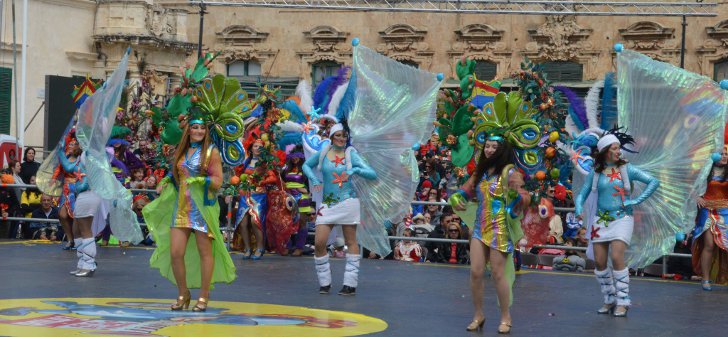The Maltese Carnival (Il-Karnival ta’ Malta) was officially introduced by Grand Master of the Order of Saint John Piero del Ponte in 1535. It featured a number of knights displaying their skills in various tournaments and attending banquets and masquerades. During the British era, Maltese carnival parades were noted for their satirical themes because the locals used them as an opportunity to make fun of unpopular government decisions. However, political satire was officially banned in 1936.
Today’s Maltese Carnival is one of the most anticipated cultural events in the country. The largest celebration takes place in Valletta and the neighboring fortified town of Floriana. The festivities start in Floriana, then relocate to Valletta and finally return to Floriana. The Carnival includes a colorful parade of allegorical floats, marching bands and costumed characters, masquerade balls, costume and mask competitions, late-night parties, and more. The festivities are presided over by King Carnival.
One of the highlights of the Carnival is the parata dance. It is a mock reenactment of the Great Siege of Malta that took place in 1565 when the Ottoman Empire tried to invade Malta but the Knights Hospitaller withstood the siege. Another Carnival tradition is an 18th-century court dance known as il-Maltija.
The Maltese Carnival is a great occasion to enjoy delicious foods before the Lenten season. Typical carnival treats in Malta include perlini (sugar coated almonds that come in all variations of pastel colors) and prinjolata (a dome-shaped cake made of sponge cake, pine nuts, almonds and cherries, covered with meringue and pine nuts).
Several more spontaneous celebrations take place in Maltese villages. The most famous one is the Nadur Carnival also known as the Macabre Carnival. It is known for its darker themes and political satire. The Nadur Carnival doesn’t have an organizing committee so no rules apply. The revelers are dressed in grotesque and rather risque costumes, there are plenty of cross-dressers and scantily clad characters.

Photo: Paul Lees




